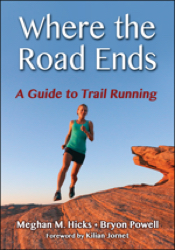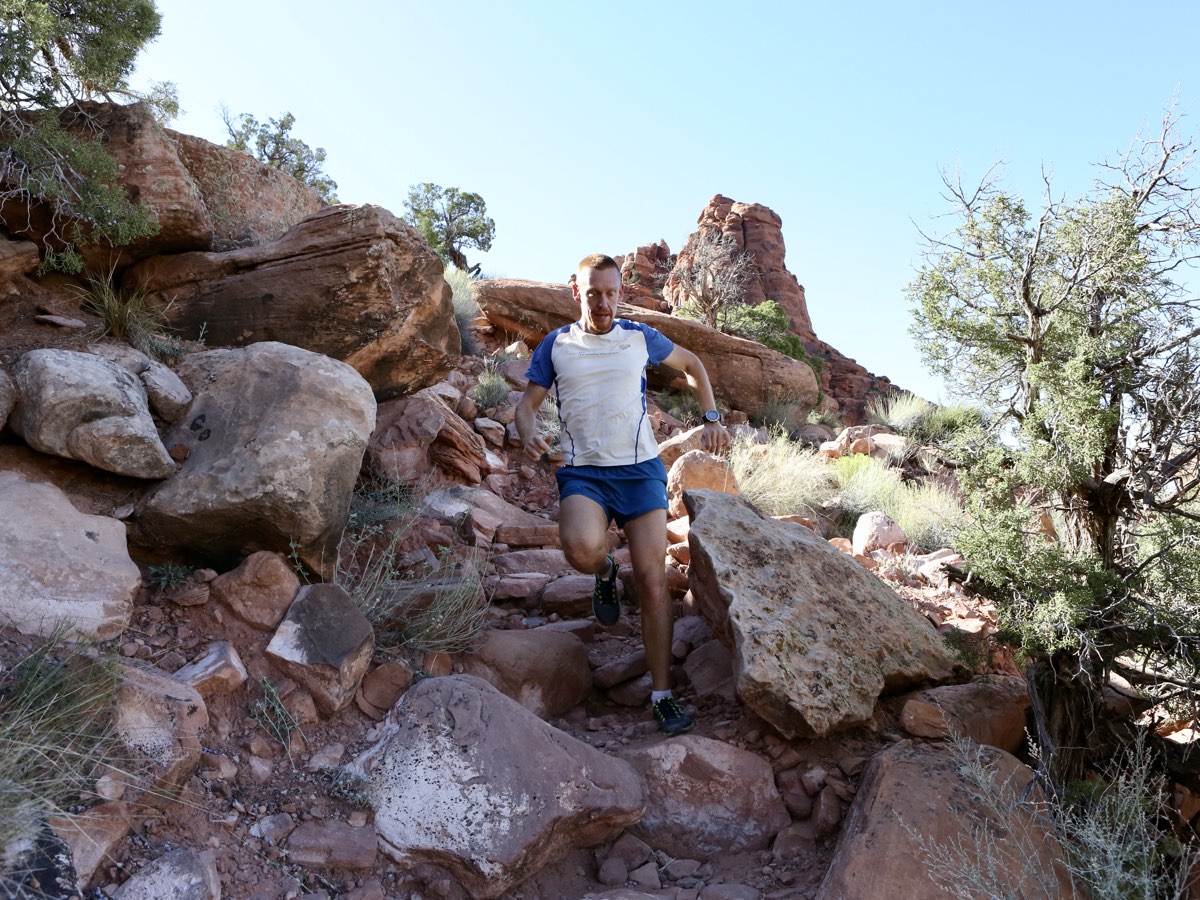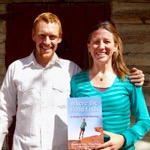
Learn more about trail running by purchasing the book “Where the Road Ends!”
Welcome to this month’s edition of “Where the Road Ends: A Guide to Trail Running!” That’s the name of both this column and the book Meghan Hicks and Bryon Powell of iRunFar published in 2016. The book Where the Road Ends: A Guide to Trail Running is a how-to guide for trail running. We worked with publisher Human Kinetics to develop a book offering the information anyone needs to get started, stay safe, and feel inspired with their trail running. The book Where the Road Ends teaches you how to negotiate technical trails, read a map, build your own training plan, understand the basics of what to drink and eat when you run, and so much more.
This column aims to do the same by publishing sections from the book as well as encouraging conversation in the comments section of each article. We want you to feel inspired and confident as you take on your first few trail runs as well as connected to iRunFar’s community of trail runners!
This month, we excerpt from Chapter 4 and share an introduction to techniques for downhill trail running. Whereas the slower pace of climbing can lend itself to taking in breathtaking views, descending on trails is a thrill in and of itself. Here, we’ll introduce the basics of how to run downhill when it’s really steep, where a lot of obstacles block the trail, and gradual descents.
Negotiating Steep Descents
Steep descents can be a blast, but the consequences can be serious should you make a mistake. That said, remaining confident and relaxed are two of the most important things you can do when running down a steep hill. Keep a slight forward lean originating from your ankles and pick up your cadence. You’ll have to read your running line quickly, while simultaneously picking up clues from farther down the trail than usual. If you need to slow down, do so gradually when you have good footing. Slamming on the brakes can get you in trouble. It’s far better to maintain a slower, consistent rate of descent than to alter your speed rapidly. Keep your arms loose and reactive. Likewise, stay loose and reactive through your lower body. Locking out any of your leg joints, which is a common reaction to muscle fatigue on descents, can be painful and may cause injury.
Anna Frost recalls, “It took me a while to get confident going straight down the mountain. There was nothing I could change apart from just doing it and getting practiced at it. That was the only thing that made me more confident.” She adds, “One of the biggest things that happened to me was getting a good pair of trail running shoes. The added traction gave me confidence to lean forward. Without that, one leans back, gets on his or her heels, skids out, and lands on his or her butt. In the end, you need to find what’s best for you on the downhill. Some of the best descenders take massive steps, while others take tiny, tiny steps. Which one is better? Neither. You need to find which is best for you. That’s part of the practice.”
Kilian Jornet echoes Frost’s call for practice, but with a twist. “To go down technical terrain fast, you cannot look to your feet because then you go too slowly. You need to look 10 feet (3 meters) in front of you and maybe 5 feet (1.5 meters) if it’s very technical. For that, you need to memorize the terrain to know how you need to put your feet and have this coordination. You can practice with some exercises like trying to run with your eyes closed for three seconds. You memorize this terrain and for these three seconds you run and you know where you put your feet.”
If you have trouble relaxing on descents, here’s what Jornet advises: “Go down as if you are dancing. Jump with the feet, with no tension in the body. Allow your body to stretch more when you go down. That’s a nice thing. Go with good music. Try to dance and enjoy the downhill so that you relax more.”
Descending With Obstacles or Poor Footing
Should you need to negotiate obstacles, especially on a steep descent, let your arms instinctively trend away from your torso. If the situation calls for rapid course corrections, your arms will flap around a bit. That is fine because they’re acting as natural counterbalances to the equally rapid lateral motions of your lower body. All the while, you’ll want to quicken your cadence to near its maximum, taking rapid-fire steps as you adjust course with each one. Try to follow the smoothest line down; you should factor in both the necessity of shifting from side to side as well as abrupt drop-offs. In other words, take the path that keeps your hips and torso on the smoothest path even if your legs and arms are going this way and that.
Descending a trail with poor footing can be one of the biggest challenges in trail running. If a hard-packed trail has just a bit of loose dust or debris, you only need to worry about that when you’re cornering, braking, or descending the steepest bits of trail. The best way to brake or take tight turns in such cases is to ease off the speed ahead of time, gradually slowing over 5 or 10 strides. When cornering, make the speed adjustment before the turn. When she started mountain racing, Brandy Erholtz found she was too slow on the descents. “I knew if I wanted to be a serious mountain runner, I had to learn how to run the downhill fast. To get better and gain confidence on the downhill, I had to practice running fast over technical terrain. I know some mountain runners who run hard up the hills and easy back down, but even on my easy days I try to work on my downhill technique.”
On a short technical descent, Jornet advises, “Lean forward and have your feet adapt to the terrain. Many times you just jump, and it’s with your feet that you touch and realize how this surface is. You need to have a lot of perception in the ankles. You see a lot of rock and you go there with the foot, and it’s when the foot touches the rocks that you say, “Okay, I will stay like this,” or “I will make it more strength on the right side or the left to keep the body in good position.”
According to Jornet, technical descents are one area where experience with other sports can be a big plus. “I think all the sports of balance like slacklining or climbing or skiing or mountain biking are good. Skiing and mountain biking are good because you are used to looking forward, to having the knowledge of how the body quickly reacts, and to choosing the good line to go down. For perceiving terrain, slacklining and climbing are good for practicing how to place the feet and building strong ankles.”
If you trail run enough you’ll encounter a moderate to steep descent with poor traction because of mud, ice, or loose debris. At times, these descents might seem impossible, but that’s rarely the case. For many trail runners, the best bet is to minimize speed going into such sections and aim to keep that speed quite low. Do not turn or brake rapidly. Have your arms slightly out to the side to help with balance and be ready to make rapid reactions should you need them. That might entail side stepping down the trail or grabbing branches, tree trunks, trailside rocks, or other fixed items to slow your speed and provide stability. Although you may have an instinctual reaction to lean back, avoid doing so because it will increase your chances of slipping and ending up on the seat of your pants. (Leaning back and landing on your bottom, however, can be a reasonably safe way to fall should you start going down. We’ll get into that more in chapter 10.)
If, or rather when, you start sliding, point your feet in the direction of the slide and ride it out, so long as that option is safe. This scenario is not unlike hitting an icy patch as discussed in the previous chapter. In both cases, reacting by turning against the slide is a good way to end up on your butt. As experienced British fell racer Tom Owens explains, “some slipping is okay. Relax and go with the flow.”
If you break out of the slide while treacherous footing persists, try to slow your speed over the next few strides, if that seems possible, or try running with very quick, short strides. Emelie Forsberg finds descending on loose terrain advantageous. “I think some of the best surfaces to run downhill on are the ones that slide, whether it is small rocks, grass and mud, or pine needles and sticks. You just have to deal with it! To let go, don’t think about anything else other than how fun it is to play with the ground, the ground that also helps you get a very fast pace. If the incline is not very steep, I can enjoy going really fast when I have control. If it’s steeper, it demands more bravery to go faster.”
On the other hand, there’s something to be said for saving your own skin. Dylan Bowman takes a more cautious approach. “When running downhill on rocky terrain, I just try to remain safe while being guided by my instincts. Most of the biggest and most painful falls I’ve taken have happened in these situations, so it’s important to have a feeling of self-preservation when descending particularly technical sections of trail. Once you feel you’re at a controlled pace, relax as much as you can and use your instincts. I’ve found that looking five or six steps ahead really helps me maintain a rhythm as opposed to staring at each individual foot strike. Widening the scope of vision will give you a better feel for the entire environment and will allow you to move with more grace and confidence. Again, keeping a good attitude and embracing the challenge are important to improving these types of skills.”

Author Bryon Powell demonstrates running downhill through technical terrain. Photo: Human Kinetics/Kirsten Kortebein
Tips for Prolonged Descents
Prolonged descents are a separate matter altogether. If you’re in the mountains, you can easily find yourself descending a few thousand feet (many hundreds of meters) at a time. Here, efficiency becomes increasingly important. Your quads are powerful muscles and can handle some serious punishment, but if you overdo the eccentric muscle contractions that occur while descending, you might find yourself walking sideways down stairs two days later. To minimize the chances that this will occur, aim to run downhill smoothly and consistently. You do not want to be running out-of-control fast, nor do you want to be braking constantly with your quads. Finding the right balance can be tough, but it’s important. Of course, if you feel like you’ve gone too hard, you can always take a break. Jornet suggests, “If you start to feel yourself going too fast and your quads are starting to work a lot, just stop for a second. Break the speed and start running again with slow, small steps to preserve your strength.”
Excerpted from Where the Road Ends: A Guide to Trail Running, by Meghan Hicks and Bryon Powell. Human Kinetics © 2016.
Call for Comments
- Do you have any other suggestions to add to this introduction to downhill trail running?
- What mistakes did you make when you first started running downhill?
